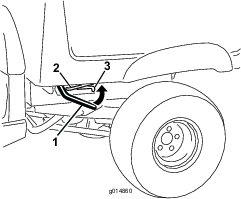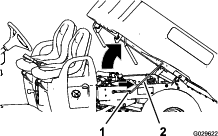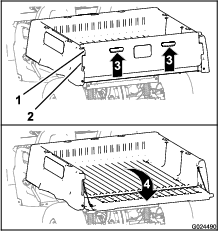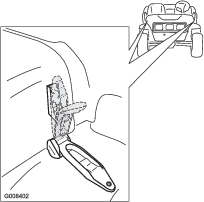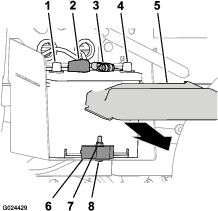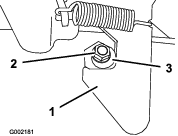| Maintenance Service Interval | Maintenance Procedure |
|---|---|
| Before each use or daily |
|
Introduction
This light utility vehicle is intended to be primarily used off-highway to transport people and material loads.
Read this information carefully to learn how to operate and maintain your product properly and to avoid injury and product damage. You are responsible for operating the product properly and safely.
Visit www.Toro.com for product safety and operation training materials, accessory information, help finding a dealer, or to register your product.
Whenever you need service, genuine Toro parts, or additional information, contact an Authorized Service Dealer or Toro Customer Service and have the model and serial numbers of your product ready. Figure 1 identifies the location of the model and serial numbers on the product. Write the numbers in the space provided.
Important: With your mobile device, you can scan the QR code on the serial number decal (if equipped) to access warranty, parts, and other product information.
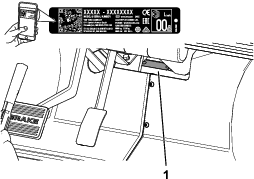
This manual identifies potential hazards and has safety messages identified by the safety-alert symbol (Figure 2), which signals a hazard that may cause serious injury or death if you do not follow the recommended precautions.

This manual uses 2 words to highlight information. Important calls attention to special mechanical information and Note emphasizes general information worthy of special attention.
This product complies with all relevant European directives; for details, please see the separate product specific Declaration of Conformity (DOC) sheet.
It is a violation of California Public Resource Code Section 4442 or 4443 to use or operate the engine on any forest-covered, brush-covered, or grass-covered land unless the engine is equipped with a spark arrester, as defined in Section 4442, maintained in effective working order or the engine is constructed, equipped, and maintained for the prevention of fire.
Please refer to the engine manufacturer’s information included with the machine.
Warning
CALIFORNIA
Proposition 65 Warning
The engine exhaust from this product contains chemicals known to the State of California to cause cancer, birth defects, or other reproductive harm.
Battery posts, terminals, and related accessories contain lead and lead compounds, chemicals known to the State of California to cause cancer and reproductive harm. Wash hands after handling.
Safety
This machine has been designed in accordance with the requirements of SAE J2258.
General Safety
This product is capable of causing personal injury. Always follow all safety instructions to avoid serious personal injury.
-
Read and understand the contents of this Operator’s Manual before you start the machine. Ensure that everyone using this product knows how to use it and understands the warnings.
-
Use your full attention while operating the machine. Do not engage in any activity that causes distractions; otherwise, injury or property damage may occur.
-
Do not put your hands or feet near moving components of the machine.
-
Do not operate the machine without all guards and other safety protective devices in place and working on the machine.
-
Keep the machine a safe distance away from bystanders while it is moving.
-
Keep children out of the operating area. Never allow children to operate the machine.
-
Stop and shut off the machine and remove the key before servicing or fueling.
Improperly using or maintaining this machine can result in injury.
To reduce the potential for injury, comply with these safety instructions
and always pay attention to the safety-alert symbol  , which means Caution, Warning,
or Danger—personal safety instruction. Failure to comply with
these instructions may result in personal injury or death.
, which means Caution, Warning,
or Danger—personal safety instruction. Failure to comply with
these instructions may result in personal injury or death.
Safety and Instructional Decals
 |
Safety decals and instructions are easily visible to the operator and are located near any area of potential danger. Replace any decal that is damaged or missing. |





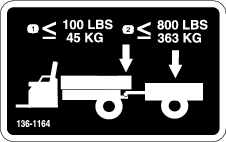

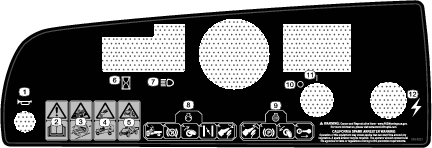
Setup
Note: Determine the left and right sides of the machine from the normal operating position.
Installing the Steering Wheel
Parts needed for this procedure:
| Steering wheel | 1 |
| Cover | 1 |
| Washer (1/2 inch) | 1 |
-
If the cover is installed, remove it from the hub of the steering wheel (Figure 3).
-
Remove the locknut (1/2 inch) from the steering shaft (Figure 3).
-
Slide the steering wheel and washer (1/2 inch) onto the steering shaft (Figure 3).
-
Secure the steering wheel to the shaft with the locknut (1/2 inch) and tighten it to 27 to 34 N∙m (20 to 25 ft-lb).
-
Install the cover on the steering wheel (Figure 3).
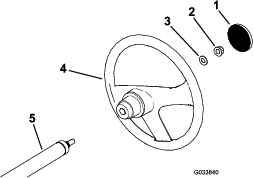
Connecting the Battery
Warning
Incorrectly routing the battery cable could damage the machine and cables, causing sparks. Sparks can cause the battery gasses to explode, resulting in personal injury.
-
Always disconnect the negative battery cable (black) before disconnecting the positive battery cable (red).
-
Always connect the positive battery cable (red) first.
-
Squeeze the battery cover to release the tabs from the battery base (Figure 4).
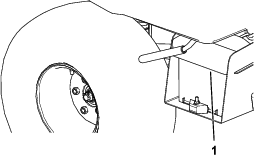
-
Remove the battery cover from the battery base (Figure 4).
-
Connect the positive battery cable (red) to the positive (+) terminal of the battery and secure the cable with the bolts and nuts (Figure 5).
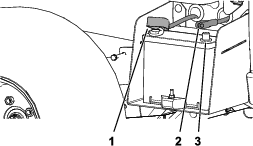
-
Slide the insulator boot over the positive terminal.
Note: The insulator boot prevents a possible short-to-ground from occurring.
-
Connect the negative battery cable (black) to the negative (–) terminal of the battery and secure the cable with the bolts and nuts.
-
Align the battery cover to the battery base (Figure 4).
-
Squeeze the battery cover, align the tabs to the battery base, and release the battery cover (Figure 4).
Checking the Fluid Levels and Tire Pressure
-
Check the engine-oil level before and after you first start the engine; refer to Checking the Engine-Oil Level.
-
Check the brake-fluid level before you first start the engine; refer to Checking the Brake-Fluid Level.
-
Check the transaxle-fluid level before you first start the engine; refer to Checking the Transaxle-Fluid Level.
-
Check the air pressure in the tires; refer to Checking the Tire Pressure.
Burnishing the Brakes
To ensure optimum performance of the brake system, burnish (break-in) the brakes before use.
-
Bring the machine up to full speed, apply the brakes to rapidly stop the machine without locking up the tires.
-
Repeat this procedure 10 times, waiting 1 minute between stops, to avoid overheating the brakes.
Important: This procedure is most effective if the machine is loaded with 227 kg (500 lb).
Reading the Manual and Viewing the Setup Material
Parts needed for this procedure:
| Operator's Manual | 1 |
| Engine owner's manual | 1 |
| Registration card | 1 |
| Predelivery Inspection Form | 1 |
| Certificate of Quality | 1 |
| Key | 2 |
-
Read the Operator's Manual and the engine owners's manual.
-
Fill out the registration card.
-
Complete the Predelivery Inspection Form.
-
Review the Certificate of Quality.
Product Overview
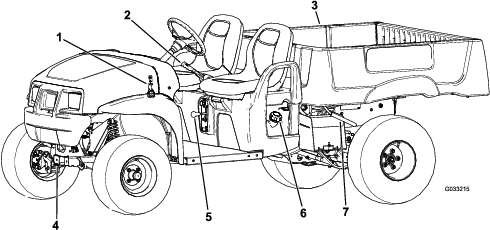
Become familiar with all the controls before you start the engine and operate the machine.
Note: Determine the left and right sides of the machine from the normal operating position.
Control Panel
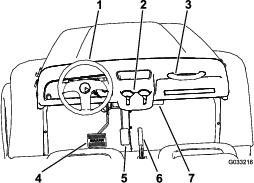
Accelerator Pedal
Use the accelerator pedal (Figure 7) to vary the ground speed of the machine. Pressing down the accelerator pedal starts the engine. Pressing the pedal farther increases the ground speed. Releasing the pedal slows the machine, and the engine shuts off.
Note: The maximum forward speed is 26 km/h (16 mph).
Brake Pedal
Use the brake pedal to stop or slow the machine (Figure 7).
Caution
Operating a machine with worn or incorrectly adjusted brakes can may result in personal injury.
If the brake pedal travels to within 25 mm (1 inch) of the machine floor board, adjust or repair the brakes.
Parking-Brake Lever
The parking-brake lever is located between the seats (Figure 6 and Figure 7). Whenever you shut off the engine, engage the parking brake to prevent the machine from accidentally moving. To engage the parking brake, pull up the parking-brake lever. To disengage the parking brake, push the lever down.
Choke Control
The choke control is located below and to the right of the operator's seat. Use the choke to help start a cold engine by pulling the choke control outward (Figure 8). After the engine starts, adjust the choke to keep the engine running smoothly. As the engine warms up, push in the choke control to the OFF position.
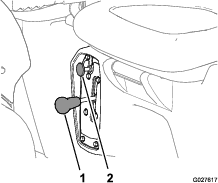
Gear-Shift Selector
The gear-shift selector is located between the seats and below the parking-brake lever. The gear-shift selector has 3 positions: FORWARD, REVERSE, and NEUTRAL (Figure 8).
Note: The engine starts and runs in any of the 3 positions.
Important: Always stop the machine before changing gears.
Horn Button
The horn button is located at the lower, left corner of the dash panel (Figure 9). Press the horn button to sound the horn.
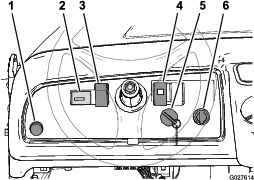
Key Switch
The key switch is located at the lower, right corner of the dash panel (Figure 9).
The key switch has 3 positions: OFF, ON, and START.
There are 2 modes of starting the machine; refer to Starting the Engine.
Light Switch
Use the light switch (Figure 9) to illuminate the headlights. Push the light switch up to turn on the headlights. Push the light switch down to turn off the lights.
Hour Meter
The hour meter indicates the total hours of machine operation. The hour meter (Figure 9) starts to function whenever you rotate the key switch to the ON position or if the engine is running.
Engine Oil-Pressure Light
The engine oil-pressure light (Figure 9) warns you if the engine-oil pressure drops below a safe level to operate the engine. If the light comes on and remains lit, shut off the engine, and check the engine-oil level. Add oil to the engine if necessary; refer to Servicing the Engine Oil.
Note: The oil light may flicker; this is normal and no action is needed.
Power Point
Use the power point (Figure 9) to power optional 12 V electrical accessories.
Fuel Gauge
The fuel gauge (Figure 10) is located on the fuel tank next to the filler cap, at the left side of the machine. The gauge displays the amount of fuel in the tank.
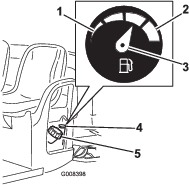
Passenger Handholds
The passenger handholds are located on the right side of the dash panel and at the outside of each seat (Figure 11).
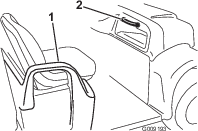
Note: Specifications and design are subject to change without notice.
| Base weight | Dry 544 kg (1,200 lb) |
| Rated capacity (on level ground) | 749 kg (1,650 lb) total, including 90.7 kg (200 lb) operator and 90.7 kg (200 lb) passenger, load, trailer tongue weight, gross trailer weight, accessories, and attachments |
| Maximum gross vehicle weight (GVW)—on level ground | 1,292 kg (2,850 lb) total, including all of the weights listed above |
| Maximum cargo capacity (on level ground) | 567 kg (1,250 lb) total, including trailer tongue weight and gross trailer weight |
| Tow capacity: | |
| Standard hitch | Tongue weight 45 kg (100 lb) Maximum trailer weight 363 kg (800 lb) |
| Heavy-duty hitch | Tongue weight 45 kg (100 lb) Maximum trailer weight 544 kg (1,200 lb) |
| Overall width | 150 cm (59 inches) |
| Overall length | 303 cm (119.3 inches) |
| Ground clearance | 25 cm (10 inches) at the front with no load or operator, 18 cm (7 inches) at the rear with no load or operator |
| Wheel base | 206 cm (81 inches) |
| Wheel tread (center line to center line) | 125 cm (49 inches) in the front, 120 cm (47-1/4 inches) in the rear |
| Cargo bed length | 117 cm (46 inches) inside, 133 cm (52-1/4 inches) outside |
| Cargo bed width | 125 cm (49 inches) inside, 150 cm (59 inches) at outside of the molded fenders |
| Cargo bed height | 25 cm (10 inches) inside |
Attachments/Accessories
A selection of Toro approved attachments and accessories is available for use with the machine to enhance and expand its capabilities. Contact your Authorized Service Dealer or authorized Toro distributor or go to www.Toro.com for a list of all approved attachments and accessories.
To ensure optimum performance and continued safety certification of the machine, use only genuine Toro replacement parts and accessories. Replacement parts and accessories made by other manufacturers could be dangerous, and such use could void the product warranty.
Operation
Before Operation
Before Operation Safety
General Safety
-
Never allow children or people who are not trained or physically capable to safely operate or service the machine. Local regulations may restrict the age of the operator. The owner is responsible for training all operators and mechanics.
-
Become familiar with the safe operation of the equipment, operator controls, and safety signs.
-
Know how to stop and shut off the machine quickly.
-
Ensure that there are not more occupants (you and your passenger(s)) than the number of handholds equipped on the machine.
-
Check that all safety devices and decals are in place. Repair or replace all safety devices and replace all illegible or missing decals. Do not operate the machine unless they are present and functioning properly.
Fuel Safety
-
Use extreme care in handling fuel. It is flammable and its vapors are explosive.
-
Extinguish all cigarettes, cigars, pipes, and other sources of ignition.
-
Use only an approved fuel container.
-
Do not remove the fuel cap or fill the fuel tank while the engine is running or hot.
-
Do not add or drain fuel in an enclosed space.
-
Do not store the machine or fuel container where there is an open flame, spark, or pilot light, such as on a water heater or other appliance.
-
If you spill fuel, do not attempt to start the engine; avoid creating any source of ignition until the fuel vapors have dissipated.
Performing Daily Maintenance
Before starting the machine each day, perform the Each Use/Daily procedures listed in .
Checking the Tire Pressure
| Maintenance Service Interval | Maintenance Procedure |
|---|---|
| Before each use or daily |
|
Tire air pressure specification: 55 to 103 kPa (8 to 22 psi)
Important: Do not exceed the maximum air pressure indicated on the sidewall of the tire.
Note: The air pressure needed in the tires is determined by the payload that you intend to carry.
-
Check the air pressure in the tires.
Note: The air pressure in the front and rear tires should be between 55 to 103 kPa (8 to 22 psi).
-
Use lower air pressure in the tires for lighter payloads, for less soil compaction, for a smoother ride, and to minimize tire marks on the ground.
-
Use higher air pressure in the tires for carrying heavier payloads at higher speeds.
-
-
If necessary, adjust the air pressure in the tires by adding or removing air in the tires.
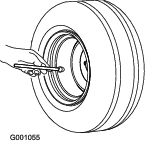
Adding Fuel
Recommended fuel:
-
For best results, use only clean, fresh (less than 30 days old), unleaded gasoline with an octane rating of 87 or higher ((R+M)/2 rating method).
-
Ethanol: Gasoline with up to 10% ethanol (gasohol) or 15% MTBE (methyl tertiary butyl ether) by volume is acceptable. Ethanol and MTBE are not the same. Gasoline with 15% ethanol (E15) by volume is not approved for use. Never use gasoline that contains more than 10% ethanol by volume, such as E15 (contains 15% ethanol), E20 (contains 20% ethanol), or E85 (contains up to 85% ethanol). Using unapproved gasoline may cause performance problems and/or engine damage which may not be covered under warranty.
-
Do not use gasoline containing methanol.
-
Do not store fuel either in the fuel tank or fuel containers over the winter unless a fuel stabilizer is used.
-
Do not add oil to gasoline.
Filling the Fuel Tank
The fuel-tank capacity is approximately 26.5 L (7 US gallons).
-
Park the machine on a level surface.
-
Engage the parking brake.
-
Shut off the engine and remove the key.
-
Clean the area around the fuel-tank cap (Figure 13).

-
Remove the fuel-tank cap.
-
Fill the tank to about 25 mm (1 inch) below the top of tank, (bottom of the filler neck).
Note: This space in the tank allows fuel to expand. Do not overfill the fuel tank..
-
Install the fuel-tank cap securely.
-
Wipe up any fuel that may have spilled.
Breaking in a New Machine
| Maintenance Service Interval | Maintenance Procedure |
|---|---|
| After the first 100 hours |
|
Perform the following guidelines to provide proper performance for the machine.
-
Ensure that the brakes are burnished; refer to Burnishing the Brakes.
-
Check the fluid and engine-oil levels regularly. Remain alert for signs that the machine or its components are overheating.
-
After starting a cold engine, let it warm up for about 15 seconds before using the machine.
Note: Allow more time for the engine to warm up when operating in cold temperatures.
-
Vary the machine speed during operation. Avoid fast starts and quick stops.
-
A break-in oil for the engine is not required. Original engine oil is the same type specified for regular oil changes.
-
Refer to for any special, low-hour checks.
-
Check the front suspension positioning and adjust it, if necessary; refer to Adjusting the Front Wheel Alignment.
During Operation
During Operation Safety
General Safety
-
The owner/operator can prevent and is responsible for accidents that may cause personal injury or property damage.
-
Passengers should sit in the designated seating positions only. Do not carry passengers in the cargo bed. Keep bystanders and pets away from the machine during operation.
-
Wear appropriate clothing, including eye protection; long pants; substantial, slip-resistant footwear; and hearing protection. Tie back long hair and do not wear loose clothing or loose jewelry.
-
Use your full attention while operating the machine. Do not engage in any activity that causes distractions; otherwise, injury or property damage may occur.
-
Do not operate the machine while ill, tired, or under the influence of alcohol or drugs.
-
Operate the machine outdoors or in a well-ventilated area only.
-
Do not exceed the maximum gross vehicle weight (GVW) of the machine.
-
Use extra caution when operating braking or turning the machine with a heavy load in the cargo bed.
-
Carrying oversized loads in the cargo bed reduces the stability of the machine. Do not exceed the carrying capacity of the bed.
-
Carrying material that cannot be bound to the machine, such as a large tank of liquid, adversely affects the steering, braking, and stability of the machine. When you carry material that cannot be bound to the machine, use caution when steering or braking.
-
Carry a reduced load and reduce the ground speed of the machine when operating on rough, uneven terrain, and near curbs, holes, and other sudden changes in terrain. Loads may shift, causing the machine to become unstable.
-
Before you start the machine, ensure that the transmission is in neutral, the parking brake is engaged, and you are in the operating position.
-
You and your passengers should remain seated whenever the machine is moving. Keep your hands on the steering wheel; your passengers should use the handholds provided. Keep your arms and legs within the machine body at all times.
-
Operate the machine only in good visibility. Watch for holes, ruts, bumps, rocks, or other hidden objects. Uneven terrain could overturn the machine. Tall grass can hide obstacles. Use care when approaching blind corners, shrubs, trees, or other objects that may obscure your vision.
-
Do not drive the machine near drop-offs, ditches, or embankments. The machine could suddenly roll over if a wheel goes over the edge or if the edge gives way.
-
Always watch out for and avoid low overhangs such as tree limbs, door jambs, overhead walkways, etc.
-
Look behind and down before reversing the machine to be sure of a clear path.
-
When using the machine on public roads, follow all traffic regulations and use any additional accessories that may be required by law, such as lights, turn signals, slow-moving vehicle (SMV) signs, and others as required.
-
If the machine ever vibrates abnormally, stop and shut off the machine immediately, wait for all movement to stop, and inspect for damage. Repair all damage to the machine before resuming operation.
-
It can take longer to stop the machine on wet surfaces than on dry surfaces. To dry out wet brakes, drive slowly on level ground while putting light pressure on the brake pedal.
-
Operating the machine at high speed and then quickly stopping may cause the rear wheels to lock up, which impairs your control of the machine.
-
Do not touch the engine, transmission, muffler, or muffler manifold while the engine is running, or soon after you shut off the engine, because these areas may be hot enough to cause burns.
-
Do not leave a running machine unattended.
-
Before leaving the operating position, do the following:
-
Park the machine on level ground.
-
Engage the parking brake.
-
Lower the cargo bed.
-
Shut off the machine and remove the key.
-
-
Do not operate the machine when there is the risk of lightning.
-
Use accessories and attachments approved by The Toro® Company only.
Slope Safety
Note: A 2-post Rollover Protection System (ROPS) is available for this machine as an accessory. Use a ROPS if you will work next to drop-offs, near water, in rough terrain, or on a slope, which could result in a rollover. Contact an Authorized Service Dealer for more information.
Slopes are a major factor related to loss-of-control and tip-over accidents, which can result in severe injury or death.
-
Survey the site to determine which slopes are safe for operating the machine and establish your own procedures and rules for operating on those slopes. Always use common sense and good judgment when performing this survey.
-
If you feel uneasy operating the machine on a slope, do not do it.
-
Keep all movement on slopes slow and gradual. Do not suddenly change the speed or direction of the machine.
-
Avoid operating the machine on wet terrain. Tires may lose traction. A rollover can occur before the tires lose traction.
-
Travel straight up and down a slope.
-
If you begin to lose momentum while climbing a slope, gradually engage the brakes and slowly reverse the machine straight down the slope.
-
Turning while going up or down a slope can be dangerous. If you must turn on a slope, do it slowly and cautiously.
-
Heavy loads affect stability on a slope. Carry a reduced load and reduce your ground speed when operating on a slope or if the load has a high center of gravity. Secure the load to the cargo bed of the machine to prevent the load from shifting. Take extra care when hauling loads that shift easily (e.g., liquids, rock, sand, etc.).
-
Avoid starting, stopping, or turning the machine on a slope, especially with a load. Stopping while going down a slope takes longer than stopping on level ground. If you must stop the machine, avoid sudden speed changes, which can cause the machine to tip or roll over. Do not engage the brakes suddenly when rolling rearward, as this may cause the machine to overturn.
Loading and Dumping Safety
-
Do not exceed the gross vehicle weight (GVW) of the machine when operating it with a load in the cargo bed and/or towing a trailer; refer to Specifications.
-
Distribute the load in the cargo bed evenly to improve the stability and control of the machine.
-
Before dumping, ensure that there is no one behind the machine.
-
Do not dump a loaded cargo bed while the machine is sideways on a slope. The change in weight distribution may cause the machine to overturn.
Operating the Cargo Bed
Raising the Cargo Bed
Warning
A raised bed could fall and injure persons that are working beneath it.
-
Always use the prop rod to hold the bed up before working under the bed.
-
Remove any load material from the bed before raising it.
Warning
Driving the machine with the cargo bed raised could cause the machine to tip or roll easier. You could damage the structure of the cargo bed if you operate the machine with the bed raised.
-
Operate the machine when the cargo bed is down.
-
After emptying the cargo bed, lower it.
Caution
If a load is concentrated near the back of the cargo bed when you release the latches, the bed may unexpectedly tip open, injuring you or bystanders.
-
Center loads in the cargo bed, if possible.
-
Hold the cargo bed down and ensure that no one is leaning over the bed or standing behind it when releasing the latches.
-
Remove all cargo from the bed before lifting the bed up to service the machine.
Lowering the Cargo Bed
Warning
The weight of the bed may be heavy. Hands or other body parts could be crushed.
Keep your hands and other body parts clear when lowering the bed.
Opening the Tailgate
Closing the Tailgate
If you unloaded loose material such as sand, landscaping rock, or wood chips from the cargo bed of the machine, some of the material that you unloaded may have lodged in the hinge area of the tailgate. Perform the following before closing the tailgate.
-
Use your hands to remove as much of the material from the hinge area as possible.
-
Rotate the tailgate to approximately the 45° position (Figure 17).
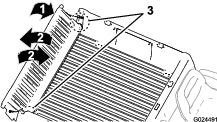
-
Use a short, shaking motion to rotate the tailgate back and forth several times (Figure 17).
Note: This action helps move material away from the hinge area.
-
Lower the tailgate and check for material remaining in the hinge area.
-
Repeat steps 1 through 4 until the material is removed from the hinge area.
-
Rotate the tailgate up and forward until the lock flanges of the tailgate are flush with the tailgate pocket in the cargo bed (Figure 16).
Note: Raise or lower the tailgate in order to align the lock flanges of the tailgate with the vertical openings between the tailgate flanges of the cargo bed.
-
Lower the tailgate until it is seated in the back of the cargo bed (Figure 16).
Note: The lock flanges of the tailgate are fully secured by the tailgate flanges of the cargo bed.
Starting the Engine
-
Sit in the operator seat, insert the key into the key switch, and rotate the key clockwise to the ON or START position.
There are 2 modes of starting the machine:
-
Pedal Start—turn the key switch to the ON position, press down the accelerator pedal, then release your foot from the accelerator pedal.
Note: When you remove your foot from the accelerator pedal, the engine shuts off.
-
Key Start—turn the key switch to the START position and the engine remains on until the is turned to the OFF position.
Note: When using key start mode, you can engage the parking brake and work away from the machine while the engine still runs and the battery holds a charge.
Note: If you turn the key to the START position, the engine cranks until it starts. If the engine cranks for more than 10 seconds, return to the OFF position, and determine the issue (e.g., the choke controls needs to be engaged, check the air cleaner for restrictions, ensure that the fuel tank is full, the spark is bad, etc.) before starting the machine again.
Note: When equipped with the optional backup alarm, if you move the gear-shift selector to the REVERSE position when the key switch is in the ON or START position, a buzzer sounds to warn the operator that the machine is in reverse gear.
-
-
Move the gear-shift selector to the desired direction of travel for the machine.
-
Disengage the parking brake.
-
Slowly step on the accelerator pedal.
Note: If the engine is cold, press and hold the accelerator pedal about half-way down, and pull the choke knob out to the ON position. Return the choke knob to the OFF position after the engine warms up.
Stopping the Machine
Important: When stopping the machine on an incline, use the service brakes to stop the machine and engage the parking brake to hold the machine in place. Using the accelerator to stall the machine on the hill can damage the machine.
-
Remove your foot from the accelerator pedal.
-
Slowly press the brake pedal to apply the service brakes until the machine comes to a complete stop.
Note: The stopping distance may vary depending on the machine load and speed.
Loading the Cargo Bed
Use the following guidelines when loading the cargo bed and operating the machine:
-
Observe the weight capacity of the machine and limit the weight of the load that you carry in the cargo bed as described in Specifications and on the gross vehicle weight tag of the machine.
Note: The load rating is specified for machine operation on a level surface only.
-
Reduce the weight of the load that you carry in the cargo bed when operating the machine on hills and rough terrain.
-
Reduce the weight of the load that you carry when the materials are tall (and have a high center of gravity), such as a stack of bricks, landscaping timbers, or fertilizer bags. Distribute the load as low as possible to ensure that the load does not reduce your ability to see behind the machine when operating it.
-
Keep loads centered by loading the cargo bed as follows:
-
Evenly position the weight in the cargo bed from side to side.
Important: Tipping over is more likely to occur if the cargo bed is loaded to 1 side.
-
Evenly position the weight in the cargo bed from front to back.
Important: Loss of steering control or the machine may tip over if you position the load behind the rear axle and the traction on the front tires is reduced.
-
-
Use extra caution when transporting oversized loads in the cargo bed, particularly when you cannot center the weight of the oversize load to the cargo bed.
-
Whenever possible, secure the load by binding it to the cargo bed so that it does not shift.
-
When transporting liquid in a large tank (such as a sprayer tank), use caution when driving the machine uphill or downhill, when suddenly changing speed or stopping, or when driving over tough surfaces.
The capacity of the cargo box is 0.37 m3 (13 ft3). The amount (volume) of material that you can place in the bed without exceeding the load ratings of the machine can vary greatly depending on the density of the material.
Refer to the following table for load volume limits with various materials:
| Material | Density | Maximum Cargo Box Capacity(on level ground) |
| Gravel, dry | 1522 kg/m3 (95 lb/ft3) | Full |
| Gravel, wet | 1922 kg/m3 (120 lb/ft3) | 3/4 Full |
| Sand, dry | 1442 kg/m3 (90 lb/ft3) | Full |
| Sand, wet | 1922 kg/m3 (120 lb/ft3) | 3/4 Full |
| Wood | 721 kg/m3 (45 lb/ft3) | Full |
| Bark | <721 kg/m3 (<45 lb/ft3) | Full |
| Earth, packed | 1602 kg/m3 (100 lb/ft3) | 3/4 Full (approximately) |
After Operation
After Operation Safety
General Safety
-
Before leaving the operating position, do the following:
-
Park the machine on a level surface.
-
Shift the transmission to the NEUTRAL position.
-
Engage the parking brake.
-
Lower all attachments.
-
Shut off the machine and remove the key.
-
-
Allow the machine to cool before adjusting, servicing, cleaning, or storing it.
-
Do not store the machine where there is an open flame, spark, or pilot light, such as on a water heater or other appliance.
-
Keep all parts of the machine in good working condition and all hardware tightened.
-
Maintain and clean the seat belt(s) as necessary.
-
Replace all worn, damaged, or missing decals.
Transporting the Machine
-
Use care when loading or unloading the machine into a trailer or a truck.
-
Use full-width ramps for loading the machine into a trailer or a truck.
-
Tie the machine down securely.
Refer to Figure 18 and Figure 19 for the tie-down locations on the machine.
Note: Load the machine on the trailer with the front of the machine facing forward. If that is not possible, secure the machine hood to the frame with a strap, or remove the hood and transport and secure it separately or the hood may blow off during transport.
Caution
Loose seats may fall off the machine and trailer when transporting the machine, and the seats may land on another machine or obstruct the roadway.
Remove the seats or make sure that the seats are securely fastened to the coupling in the seat shroud.
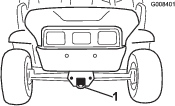

Towing the Machine
In case of an emergency, you can tow the machine for a short distance; however, this should not be a standard operating procedure.
Warning
Towing at excessive speeds could cause a loss of steering control, resulting in personal injury.
Never tow the machine at faster than 8 km/h (5 mph).
Note: The power steering does not function, making it difficult to steer.
Towing the machine is a 2-person job. If you must move the machine a considerable distance, transport it on a truck or trailer; refer to Towing a Trailer
-
Remove the drive belt from the machine; refer to Replacing the Drive Belt.
-
Affix a tow line to the tongue at the front of the machine frame (Figure 18).
-
Move the transmission to the NEUTRAL position and disengage the parking brake.
Towing a Trailer
The machine is capable of pulling trailers. A tow hitch is available for the machine. Contact your Authorized Service Dealer for details.
When hauling cargo or towing a trailer, do not overload your machine or trailer. Overloading either the machine or the trailer can cause poor performance or damage to the brakes, axle, engine, transaxle, steering, suspension, body structure, or tires.
Always load a trailer with 60% of the cargo weight in the front of the trailer. This places approximately 10% of the gross trailer weight (GTW) on the tow hitch of the machine.
To provide adequate braking and traction, always load the cargo bed when using a trailer. Do not exceed the GTW or GVW limits.
Avoid parking a machine with a trailer on a hill. If you must park on a hill, engage the parking brake, and chock the tires of the trailer.
Maintenance
Note: Determine the left and right sides of the machine from the normal operating position.
Note: Download a copy of the electrical schematic by visiting www.Toro.com and searching for your machine from the Manuals link on the home page.
Important: Refer to your engine owner’s manual for additional maintenance procedures.
Warning
Failure to properly maintain the machine could result in premature failure of machine systems, causing possible harm to you or bystanders.
Keep the machine well maintained and in good working order as indicated in these instructions.
Caution
Only qualified and authorized personnel should maintain, repair, adjust, or inspect the machine.
-
Avoid fire hazards and have fire-protection equipment present in the work area. Do not use an open flame to check fluid levels or leakage of fuel, battery electrolyte, or coolant.
-
Do not use open pans of fuel or flammable cleaning fluids for cleaning parts.
Caution
If you leave the key in the key switch, someone could accidently start the engine and seriously injure you or other bystanders.
Remove the key from the key switch and disconnect the wires from the spark plugs before you do any maintenance. Set the wires aside so that they do not accidentally contact the spark plugs.
Maintenance Safety
-
Do not allow untrained personnel to service the machine.
-
Before servicing or making any adjustments to the machine, do the following:
-
Park the machine on a level surface.
-
Move the transmission to the NEUTRAL position.
-
Engage the parking brake.
-
Lower all attachments.
-
Shut off the machine and remove the key.
-
-
Support the machine with jack stands whenever you raise the machine.
-
Do not work under a raised bed without the proper bed safety support in place.
-
Do not charge the batteries while servicing the machine.
-
To ensure that the entire machine is in good condition, keep all hardware properly tightened.
-
To reduce the potential fire hazard, keep the machine area free of excessive grease, grass, leaves, and accumulation of dirt.
-
If possible, do not perform maintenance while the machine is running. Keep away from moving parts.
-
If you must run the machine to perform a maintenance adjustment, keep your hands, feet, clothing, and any parts of the body away from any moving parts. Keep bystanders away from the machine.
-
Clean up oil and fuel spills.
-
Check the parking brake operation as recommended in the maintenance schedule and adjust and service it as required.
-
Keep all parts of the machine in good working condition and all the hardware properly tightened. Replace all worn or damaged decals.
-
Never interfere with the intended function of a safety device or reduce the protection provided by a safety device.
-
Do not overspeed the engine by changing the governor settings. To ensure safety and accuracy, have an Authorized Service Dealer check the maximum engine speed with a tachometer.
-
If major repairs are ever necessary or assistance is required, contact an Authorized Service Dealer.
-
Altering this machine in any manner may affect the operation of the machine, performance, durability, or its use may result in injury or death. Such use could void the product warranty of The Toro® Company.
Recommended Maintenance Schedule(s)
| Maintenance Service Interval | Maintenance Procedure |
|---|---|
| After the first 8 hours |
|
| After the first 25 hours |
|
| After the first 50 hours |
|
| After the first 100 hours |
|
| Before each use or daily |
|
| Every 100 hours |
|
| Every 200 hours |
|
| Every 300 hours |
|
| Every 400 hours |
|
| Every 600 hours |
|
| Every 800 hours |
|
| Every 1,000 hours |
|
Maintaining the Machine under Special Operating Conditions
Important: If the machine is subjected to any of the conditions listed below, perform maintenance twice as frequently:
-
Desert operation
-
Cold climate operation—below 10°C (50°F)
-
Trailer towing
-
Frequent operation in dusty conditions
-
Construction work
-
After extended operation in mud, sand, water, or similar dirty conditions, have your brakes inspected and cleaned as soon as possible. This prevents any abrasive material from causing excessive wear.
Pre-Maintenance Procedures
Many of the subjects covered in this maintenance section require raising and lowering the bed. To prevent serious injury or death, take the following precautions.
Preparing the Machine for Maintenance
-
Park the machine on a level surface.
-
Engage the parking brake.
-
Shut off the engine and remove the key.
-
Empty and raise the cargo bed; refer to Operating the Cargo Bed.
Lifting the Machine
Danger
The machine may be unstable when using a jack. The machine could slip off the jack, injuring anyone beneath it.
-
Do not start the machine while the machine is on a jack.
-
Always remove the key from the key switch before getting off the machine.
-
Block the tires when the machine is supported by lifting equipment.
-
Use jack stands to support the machine once you have lifted it.
Important: Whenever you run the machine for routine maintenance and/or diagnostics, ensure that the rear wheels of the machine are 25 mm (1 inch) off the ground, with the rear axle supported on jack stands.
-
The lifting point at the front of the machine is located at the front of the frame, behind the towing tongue (Figure 20).
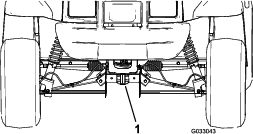
-
The lifting point at the rear of the machine is located under the axle tubes (Figure 21).

Lubrication
Greasing the Machine
| Maintenance Service Interval | Maintenance Procedure |
|---|---|
| Every 100 hours |
|
Grease Type: No. 2 lithium grease
-
Use a rag to wipe the grease fitting clean so that foreign matter cannot be forced into the bearing or bushing.
-
With a grease gun, apply 1 or 2 pumps of grease into the grease fittings on the machine.
-
Wipe the excess grease off the machine.
The grease fittings are located at the inner end of the control arms, the tie-rod ball joint, and the outer end of the control arms (Figure 23 and Figure 24).
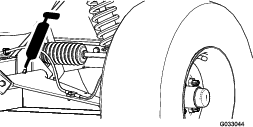
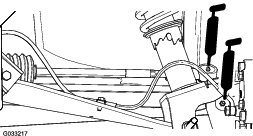
Greasing the Front Wheel Bearings
| Maintenance Service Interval | Maintenance Procedure |
|---|---|
| Every 300 hours |
|
Grease specification: Mobilgrease XHP™-222
Removing the Hub and Rotor
-
Lift the front of the machine and support it with jack stands.
-
Remove the 4 lug nuts that secure the wheel to the hub (Figure 25).
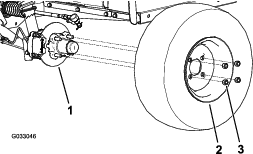
-
Remove the flange-head bolts (3/8 x 3/4 inch) that secure the bracket for the brake assembly to the spindle and separate the brake from the spindle (Figure 26).
Note: Support the brake assembly before proceeding to the next step.
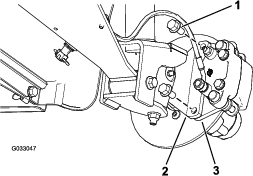
-
Remove the dust cap from the hub (Figure 27).

-
Remove the cotter pin and nut retainer from the spindle and spindle nut (Figure 27).
-
Remove the spindle nut from the spindle, and separate the hub and rotor assembly from the spindle (Figure 27 and Figure 28).
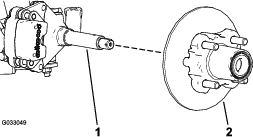
-
Wipe clean the spindle with a rag.
-
Repeat steps 1 through 7 to the hub and rotor at the other side of the machine.
Greasing the Wheel Bearings
-
Remove the outboard bearing and bearing race from the hub (Figure 29).
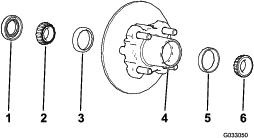
-
Remove the seal, inboard bearing from the hub (Figure 29).
-
Wipe clean the seal and check for wear and damage.
Note: Do not use cleaning solvent to clean the seal. Replace the seal if it is worn or damaged.
-
Clean the bearings and races, and check these parts for wear and damage.
Note: Replace all worn or damaged parts. Ensure that the bearings and races are clean and dry.
-
Clean the cavity of the hub of all grease, dirt, and debris (Figure 29).
-
Pack the bearings with the specified grease.
-
Fill the cavity of hub 50 to 80% full of the specified grease (Figure 29).
-
Assemble the inboard bearing onto the race at the inboard side of the hub and install the seal (Figure 29).
-
Repeat steps 1 through 8 to the bearings for the other hub.
Installing the Hub and Rotor
-
Apply a light coat of the specified grease to the spindle (Figure 30).
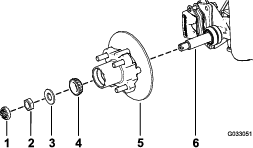
-
Assemble the hub and rotor onto the spindle with the rotor inboard (Figure 30).
-
Assemble the outboard bearing onto the spindle and seat the bearing to the outboard race (Figure 30).
-
Assemble the tab washer onto the spindle (Figure 30).
-
Thread the spindle nut onto the spindle and tighten the nut to 15 N∙m (11 ft-lb), while rotating the hub to seat the bearing (Figure 30).
-
Loosen the spindle nut until the hub rotates freely.
-
Torque the spindle nut to 170 to 225 N∙cm (15 to 20 in-lb).
-
Install the retainer over the nut and check the alignment of the slot in the retainer and the hole in the spindle for the cotter pin (Figure 31).
Note: If the slot in the retainer and the hole in the spindle are not aligned, tighten the spindle nut to align the slot and hole to a maximum torque of 226 N∙cm (20 in-lb) on the nut.
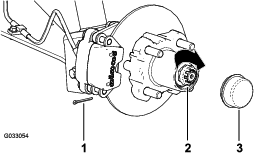
-
Install the cotter pin and bend each legs around the retainer (Figure 31).
-
Install the dust cap onto the hub (Figure 31).
-
Repeat steps 1 through 10 for the hub and rotor at the other side of the machine.
Installing the Brakes and Wheels
-
Clean the 2 flange-head bolts (3/8 x 3/4 inch) and apply a coat of medium-strength thread-locking compound to the threads of the bolts.
-
Align the brake pads to either side of the rotor (Figure 26) and the holes in the caliper bracket with the holes in the brake mount of the spindle frame (Figure 30).
-
Secure the caliper bracket to the spindle frame (Figure 26) using the 2 flange-head bolts (3/8 x 3/4 inch).
Torque the 2 flange-head bolts to 47 to 54 N∙m (35 to 40 ft-lb).
-
Align the holes in the wheel to the studs of the hub and assemble the wheel to the hub with the valve stem outward (Figure 25).
Note: Ensure that the mounting surface of the wheel is flush with the hub.
-
Secure the wheel to the hub using the lug nuts (Figure 25).
Torque the lug nuts to 108 to 122 N∙m (80 to 90 ft-lb).
-
Repeat steps 1 through 5 for the brake and wheel on the other side of the machine.
Engine Maintenance
Engine Safety
-
Shut off the engine, remove the key, and wait for all moving parts to stop before checking the oil or adding oil to the crankcase.
-
Keep your hands, feet, face, clothing, and other body parts away from the muffler and other hot surfaces.
Servicing the Air Filter
| Maintenance Service Interval | Maintenance Procedure |
|---|---|
| Every 100 hours |
|
Note: Service the air filter more frequently (every few hours) if operating conditions are extremely dusty or sandy.
Checking the Air Filter
-
Raise the cargo bed and secure it with the prop rod.
-
Check the air-cleaner body for damage which could possibly cause an air leak (Figure 32 and Figure 33).
Note: Ensure the cover seals around the air-filter body.
Note: Replace a damaged air-filter cover or housing.
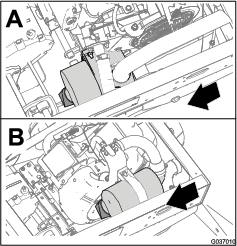
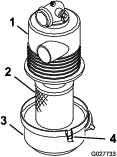
-
Release the latches securing the air-filter cover to the air-filter housing (Figure 33).
-
Separate the air-filter cover from the air-filter housing, and clean the inside of the cover (Figure 33).
-
Gently slide the air-filter element out of the filter housing.
Note: To reduce the amount of dust dislodged, avoid knocking the filter against the air-filter housing.
-
Inspect the air-filter element.
-
If the air-filter element is clean, install the filter element; refer to Installing the Air Filter.
-
If the air-filter element is damaged, replace the filter element; refer to Replacing the Air Filter.
-
Replacing the Air Filter
-
Remove the air-filter element.
-
Inspect the new filter for shipping damage.
Note: Check the sealing end of the filter.
Important: Do not install a damaged filter.
-
Install the new air filter; refer to Installing the Air Filter.
Installing the Air Filter
Important: To prevent engine damage, always operate the engine with the complete air cleaner assembly installed.
Important: Do not use a damaged element.
Note: Cleaning of the used air-filter element is not recommended due to the possibility of damage to the filter media.
-
Clean the dirt ejection port located on the air-filter cover.
-
Remove the rubber outlet valve from the cover, clean the cavity, and replace the outlet valve.
-
Insert the air-filter element into air-filter housing (Figure 33).
Note: Ensure that the filter is sealed properly by applying pressure to the outer rim of the filter when installing it. Do not press on the flexible center of the filter.
-
Align the air-filter cover with the air-filter housing (Figure 33).
-
Secure the cover to the housing with the latches (Figure 33).
-
Lower the cargo bed.
Servicing the Engine Oil
| Maintenance Service Interval | Maintenance Procedure |
|---|---|
| After the first 25 hours |
|
| Every 100 hours |
|
Note: Change the oil more frequently when operating conditions are extremely dusty or sandy.
Note: Dispose of the used engine oil and oil filter at a certified recycling center.
Engine-Oil Specifications
Oil Type: Detergent oil (API service SL or higher)
Crankcase Capacity: 1.4 L (1.5 US qt) when the filter is changed
Viscosity: See the table below.
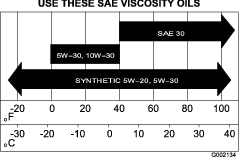
Checking the Engine-Oil Level
| Maintenance Service Interval | Maintenance Procedure |
|---|---|
| Before each use or daily |
|
-
Park the machine on a level surface.
-
Engage the parking brake.
-
Shut off the engine and remove the key.
-
Raise the cargo bed.
-
Use a rag to clean around the oil dipstick and fill cap (Figure 35) so that dirt cannot fall into the dipstick tube or oil-filler neck and damage the engine.
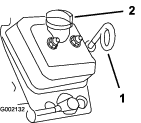
-
Remove the dipstick and wipe it clean (Figure 35).
-
Slide the dipstick into the dipstick tube and ensure that fully seats (Figure 35).
-
Pull the dipstick out and look at the end.
-
If the oil level is low, remove the filler cap and add the specified oil into the filler neck to raise the level up to Full mark on the dipstick.
Note: Add the oil slowly and check the oil level often during this process. Do not overfill the engine with oil.
-
Install the filler cap (Figure 35).
-
Install the oil dipstick and firmly seat it (Figure 35).
Important: Make sure that the loop end of the oil dipstick is pointing down.
-
Lower the cargo bed.
Changing the Engine Oil
-
Park the machine on a level surface.
-
Engage the parking brake.
-
Start the machine and let the engine run for a few minutes.
-
Shut off the engine and remove the key.
-
Raise the cargo bed and secure it with the prop rod.
-
Disconnect the negative battery cable; refer to Disconnecting the Battery.
-
Place a drain pan under the drain plug (Figure 36).
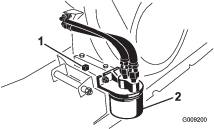
-
Remove the drain plug and seal (Figure 36).
Note: Allow the oil to completely drain from the engine.
-
Install the drain plug and seal, and torque the drain plug to 17.6 N∙m (13 ft-lb).
-
Pour oil into the fill opening until the oil level is up to the Full mark on the dipstick.
Note: Do not overfill the engine with oil.
-
Install the oil-fill cap and dipstick firmly in place.
-
Connect the battery and lower the cargo bed.
Changing the Engine-Oil Filter
| Maintenance Service Interval | Maintenance Procedure |
|---|---|
| After the first 25 hours |
|
| Every 100 hours |
|
-
Drain the oil from the engine.
-
Remove the existing oil filter (Figure 36).
-
Apply a light coat of clean oil to the gasket of the new oil filter.
-
Thread the new filter onto the filter adapter until the gasket contacts the mounting plate, then tighten the filter an additional 1/2 to 3/4 turn (Figure 36).
Important: Do not overtighten the oil filter.
-
Fill the crankcase with the specified oil (Figure 34).
-
Start and run the engine to check for oil leaks.
-
Shut off the engine and check the engine-oil level.
Note: If necessary, add the specified oil into the engine until the oil level is at the Full mark on the dipstick.
Servicing the Spark Plugs
| Maintenance Service Interval | Maintenance Procedure |
|---|---|
| Every 100 hours |
|
Type: Champion RN14YC (or equivalent)
Air Gap: 0.762 mm (0.03 inch)
Important: A cracked, fouled, dirty, or malfunctioning spark plug must be replaced. Do not sand-blast, scrape, or clean electrodes by using a wire brush because grit may eventually release from the plug and fall into the cylinder. The result is usually a damaged engine.
Note: The plug should be removed and checked whenever the engine malfunctions.
-
Clean the area around the spark plug so that foreign matter cannot fall into the cylinder when you remove the spark plug.
-
Pull the wire off the terminal of the spark plug.
-
Remove the plug from the cylinder head.
-
Check the condition of the side electrode, center electrode, and center electrode insulator to ensure that there is no damage (Figure 37).
Note: Do not use a damaged or worn spark plug. Replace it with a new spark plug of the specified type.
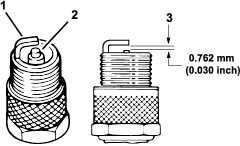
-
Set the air gap between the center and side of the electrodes at 0.762 mm (0.030 inch) as shown in Figure 37.
-
Install the spark plug into the cylinder head, and torque the plug to 20 N∙m (14.7 ft-lb).
-
Install the spark-plug wire.
-
Repeat steps 1 through 7 for the other spark plug.
Adjusting the High/Low Idle
-
Lift the cargo bed and secure it open with the prop rod.
-
With the machine off, fully depress the accelerator pedal and measure the gap between the leading edge of the governor bellcrank and the bracket tab. This gap should be between 0.8 to 2.0 mm (.03 to .08 inches).
-
At the throttle cable, loosen the forward jam nut and tighten the rear jam nut to increase the low idle (Figure 38).
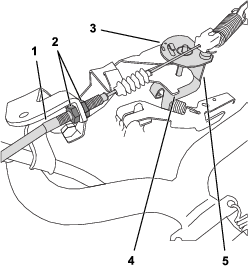
-
Test the high idle with a tachometer:
-
Turn the engine on.
-
Ensure that the shift lever is in the neutral position.
-
Fully depress the accelerator pedal and measure the engine speed with a tachometer; the engine speed should be between 3550 to 3650 rpm. If it is not, shut off the engine and adjust the cable jam nuts.
Important: Do not lower the high idle. Test with a tachometer to ensure that the high idle is between 3550 to 3650 rpm.
-
-
Push on the prop rod and lower the cargo bed.
Fuel System Maintenance
Inspecting Fuel Lines and Connections
| Maintenance Service Interval | Maintenance Procedure |
|---|---|
| Every 400 hours |
|
Inspect the fuel lines, fittings, and clamps for signs of leaking, deterioration, damage, or loose connections.
Note: Repair any damaged or leaking fuel system component before using the machine.
Replacing the Fuel Filter
| Maintenance Service Interval | Maintenance Procedure |
|---|---|
| Every 800 hours |
|
-
Raise the bed and support it with the prop rod.
-
Rotate the key switch to the OFF position and remove the key.
-
Disconnect the battery; refer to Disconnecting the Battery.
-
Place a drain pan under the fuel filter.
-
Remove the clamps securing the fuel filter to the fuel lines (Figure 39).
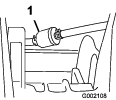
-
Remove the old fuel filter from the fuel lines.
Note: Drain the old filter and discard it at a certified recycling center.
-
Install the replacement filter to the fuel lines so that the arrow points toward the carburetor.
-
Secure the filter to the lines with the clamps the you removed in step 5.
-
Connect the battery and lower the cargo bed; refer to Connecting the Battery.
Servicing the Carbon Canister
Checking the Air Filter for the Carbon Canister
| Maintenance Service Interval | Maintenance Procedure |
|---|---|
| Every 100 hours |
|
Check the opening at the bottom of the air filter for the carbon canister to ensure that it is clean and free of debris and obstructions (Figure 40).
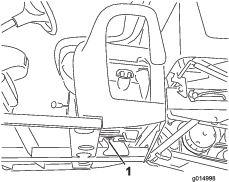
Replacing the Carbon-Canister Filter
| Maintenance Service Interval | Maintenance Procedure |
|---|---|
| Every 200 hours |
|
-
Remove the barbed fitting of the carbon-canister filter from the hose at the bottom of the carbon canister, and remove the filter.
Note: Discard the old filter.
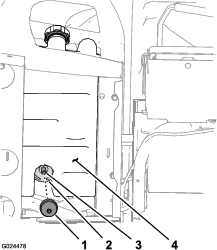
-
Fully insert the barbed fitting of the new carbon-canister filter into the hose at the bottom of the carbon canister.
Replacing the Carbon Canister
Note: Replace the carbon canister if it is damaged, plugged, or if the machine is run without a carbon-canister filter.
Note: Replace the carbon-canister filter when replacing the carbon canister.
Disconnecting the Controls at the Seat Base
Disconnecting the Parking-Brake Cable
-
At the bottom of the machine, remove the cable tie that secures the parking-brake cable to the service brake line (Figure 43).
-
Mark a rotation stripe on the forward jam nut for the parking-brake cable (Figure 43).
Note: Ensure that the forward-jam nut does not rotate.
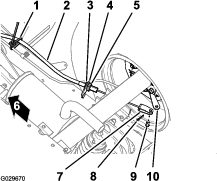
-
Loosen the rear-jam nut and remove the cable from the brake-cable bracket (Figure 43).
-
Remove the cotter pin and the clevis pin that secure the clevis for the parking-brake cable to the brake-actuating lever and separate the cable from the lever (Figure 43).
-
Repeat steps 1 through 4 to the parking-brake cable at the other side of the machine.
Removing the Seats and Seat Bases
-
At the bottom of the machine, remove the 8 flange-head bolts and 8 washers that secure the seat base to the floor plate and rear-cab channel (Figure 44).
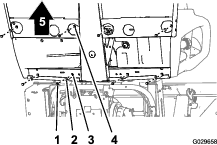
-
Carefully lift the seats, seat base, and parking brake cables from the machine (Figure 44).
Important: Note the routing of the parking-brake cables along the chassis as you lift the seats and seat base from the machine.
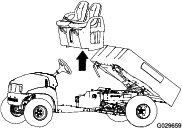
Replacing the Carbon Canister
-
Remove the vacuum hose from the fitting on the carbon canister marked Purge (Figure 46).
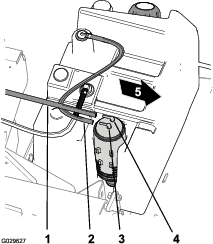
-
Remove the fuel-tank hose from the fitting on the carbon canister marked Fuel Tank (Figure 46).
-
Lift the carbon canister from the carbon-canister mount in the fuel tank (Figure 47).
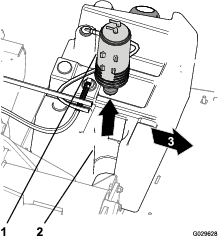
-
Remove the carbon-canister filter and the short section of hose from the lower fitting of the old carbon canister (Figure 48).

-
Install the hose onto the lower fitting of the new carbon canister (Figure 48).
-
Insert the fitting of a new carbon-canister filter into the hose (Figure 48).
-
Insert the new carbon canister into the carbon-canister mount of the fuel tank with the purge and fuel tank fittings aligned rearward (Figure 47).
-
Assemble the vacuum hose onto the fitting on the carbon canister marked Purge and the fuel-tank hose to the onto the fitting marked Fuel Tank (Figure 46).
Installing the Seats and Seat Base
-
Lift the seats and seat base onto the machine and align brake cables to the chassis (Figure 44 and Figure 45).
-
Align the holes in the seat base with the holes in the floor plate and rear-cab channel (Figure 44 and Figure 45).
-
Assemble the seat base to the floor plate and rear-cab channel with the 8 flange-head bolts and 8 washers that you removed in step 1 of Removing the Seats and Seat Bases and torque the bolts to 1,978 to 2,542 N∙cm (175 to 225 in-lb).
Installing the Parking Brake Cables
-
Route the threaded adjuster of the parking-brake cable to the brake-cable bracket and the clevis to the brake-actuating lever (Figure 43).
-
Secure the clevis to the brake-actuating lever with the clevis pin and cotter pin the you removed in step 4 of Disconnecting the Parking-Brake Cable.
-
Align the threaded adjuster of the parking -brake cable to the brake-cable bracket and tighten the rear-jam nut (Figure 43).
Note: Ensure the you do not rotate the forward-jam nut.
-
Repeat steps 1 through 3 to the parking-brake cable at the other side of the machine.
Connecting the Controls at the Seat Base
-
Connect the electrical connector from the reverse switch that is located inside the gear shift bracket.
-
Align the holes in the shifter bracket to the holes in the seat base and secure the plate to the base with the 4 bolts that you removed in step 3 of Disconnecting the Controls at the Seat Base.
-
Align the holes in the shifter plate to the holes in the shifter bracket and secure the plate to the bracket with the 4 bolts that you removed in step 2 of Disconnecting the Controls at the Seat Base.
-
Thread the knob from the gear-shift lever and tighten the knob by hand (Figure 42).
Electrical System Maintenance
Electrical System Safety
-
Disconnect the battery before repairing the machine. Disconnect the negative terminal first and the positive last. Connect the positive terminal first and the negative last.
-
Charge the battery in an open, well-ventilated area, away from sparks and flames. Unplug the charger before connecting or disconnecting the battery. Wear protective clothing and use insulated tools.
Servicing the Battery
Battery voltage: 12 V with 300 A (cold-cranking) at -18°C (0°F).
-
Always keep the battery clean and fully charged.
-
If the battery terminals are corroded, clean them with a solution of 4 parts water and 1 part baking soda.
-
Apply a light coating of grease to the battery terminals to prevent corrosion.
Disconnecting the Battery
Warning
Incorrect battery cable routing could damage the machine and cables, causing sparks. Sparks can cause the battery gasses to explode, resulting in personal injury.
-
Always disconnect the negative (black) battery cable before disconnecting the positive (red) cable.
-
Always connect the positive (red) battery cable before connecting the negative (black) cable.
-
Always keep the battery strap in place to protect and secure the battery.
Warning
Battery terminals or metal tools could short against metal machine components, causing sparks. Sparks can cause the battery gasses to explode, resulting in personal injury.
-
When removing or installing the battery, do not allow the battery terminals to touch any metal parts of the machine.
-
Do not allow metal tools to short between the battery terminals and metal parts of the machine.
Removing the Battery
-
Disconnect the battery cables; refer to Disconnecting the Battery.
-
Remove the locknut, carriage bolt, and battery clamp that secures the battery to the battery tray (Figure 49).
-
Remove the battery from the battery tray (Figure 49).
Installing the Battery
-
Align the battery to the battery tray of the machine (Figure 49).
Note: Ensure that the positive and negative posts of the battery are aligned as shown in Figure 49.
-
Secure the battery to the battery tray with the battery clamp, carriage bolt, and locknut (Figure 49).
-
Connect the battery cables; refer to Connecting the Battery.
Connecting the Battery
Charging the Battery
Warning
Charging the battery produces gasses that can explode.
Never smoke near the battery and keep sparks and flames away from battery.
Important: Always keep the battery fully charged (1.260 specific gravity). This is especially important to prevent battery damage when the temperature is below 0°C (32°F).
-
Remove the battery from the machine; refer to Disconnecting the Battery.
-
Connect a 3 to 4 A battery charger to the battery posts. Charge the battery at a rate of 3 to 4 A for 4 to 8 hours (12 V).
Note: Do not overcharge the battery.
-
Install the battery in the chassis; refer to Installing the Battery.
Storing the Battery
If you are storing the machine for more than 30 days, remove the battery and charge it fully. Either store it on the shelf or on the machine. Leave the cables disconnected if it is stored on the machine. Store the battery in a cool atmosphere to avoid quick deterioration of the charge in the battery. To prevent the battery from freezing, make sure that it is fully charged.
Replacing the Fuses
There are 4 fuses in the electrical system. They are located beneath the hood (Figure 50).
| Lift/gate (Open) | 30 A |
| Horn/power point | 20 A |
| Headlights | 15 A |
| Machine fuse | 10 A |
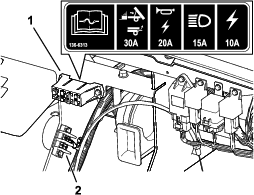
Maintaining the Headlights
Replacing the Bulbs
Caution
If you install a higher wattage bulb than the system is designed for, you may damage the 12 V power supply, or at a minimum, blow the fuse.
Always use the specified Toro LED bulb to prevent this issue.
Caution
The bulbs become extremely hot when in operation. Handling a hot bulb can cause severe burns and personal injury.
Always allow enough time to for the bulbs to cool before replacing them. Use care whenever handling the bulbs.
Specification: See your Parts Catalog.
-
Disconnect the battery; refer to Disconnecting the Battery.
-
Open the hood.
-
Disconnect the electrical connector for the harness from the connector of the lamp assembly at the back of the headlight housing (Figure 51).
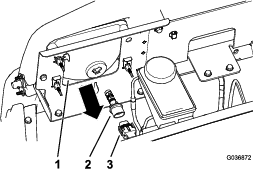
-
Rotate the lamp assembly 1/4 turn counterclockwise and moving it rearward, out of the headlight housing (Figure 51).
-
Insert the new lamp assembly and headlight housing and align the tabs in the lamp assembly with the slots in the headlight housing (Figure 51).
-
Secure lamp assembly by turning it 1/4 turn clockwise (Figure 51).
-
Connect the electrical connector for the harness to the connector of the new lamp assembly (Figure 51).
-
Connect the battery and close the hood; refer to Connecting the Battery.
Replacing the Headlight
-
Disconnect the battery; refer to Disconnecting the Battery.
-
Open the hood; refer to Raising the Hood.
-
Disconnect the electrical connector for the harness from the connector of the lamp assembly (Figure 52).
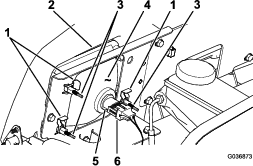
-
Remove the speed clips that secure the headlight to the headlight bracket (Figure 52).
Note: Retain all parts for installation of the new headlight.
-
Remove the headlight assembly by moving it forward through the opening in the front bumper (Figure 52).
-
Install the new headlight through the opening in the bumper (Figure 52).
Note: Ensure the adjustment posts are lined up with the holes in the mounting bracket behind the bumper.
-
Secure the headlight assembly with the speed clips that you removed in step 4.
-
Connect the electrical connector for the harness to the connector of the lamp assembly (Figure 52).
-
Adjust the headlights to direct the beams to the desired position, refer to Adjusting the Headlights.
Adjusting the Headlights
Use the following procedure to adjust the headlight beam position whenever a headlight assembly is replaced or removed.
-
Turn the key switch to the ON position, and turn on the headlights.
-
At the back of the headlight assembly, rotate adjustment screws (Figure 52) to pivot the headlight assembly and align the position of the cast beam.
Drive System Maintenance
Maintaining the Tires
| Maintenance Service Interval | Maintenance Procedure |
|---|---|
| Every 100 hours |
|
-
Inspect the tires and rims for signs of wear and damage.
Note: Operating accidents, such as hitting curbs, can damage a tire or rim and also disrupt wheel alignment, so inspect tire condition after an accident.
-
Torque the wheel lug nuts to 108 to 122 N∙m (80 to 90 ft-lb).
Inspecting the Steering and Suspension Components
| Maintenance Service Interval | Maintenance Procedure |
|---|---|
| Every 100 hours |
|
With the steering wheel at the centered position (Figure 53), turn the steering wheel to the left or right. If you turn the steering wheel more than 13 mm (1/2 inch) to the left or right, and the tires do not turn, check the following steering and suspension components to ensure that they are not loose or damaged:
-
Steering shaft to the steering-rack assembly joint
Important: Inspect the condition and security of the pinion-shaft seal (Figure 54).
-
Steering-rack assembly tie rods
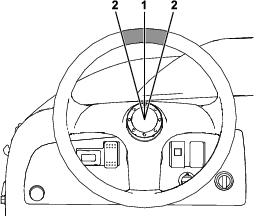
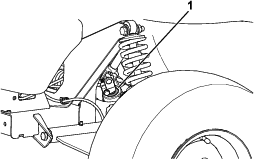
Adjusting the Front Wheel Alignment
| Maintenance Service Interval | Maintenance Procedure |
|---|---|
| Every 100 hours |
|
Preparing to Adjust Camber or Toe-in
-
Check the tire pressure to ensure that the front tires are inflated to 82 kPa (12 psi).
-
Either add weight to the driver's seat equal to the average operator who will run the machine, or have an operator sit on the seat. The weight or operator must remain on the seat for the duration of the adjustment procedure.
-
On a level surface, roll the machine straight back 2 to 3 m (6 to 10 ft) and then straight forward to the original starting position. This allows the suspension to settle into the operating position.
Adjusting the Camber
Owner provided tools: spanner wrench, Toro Part No. 132-5069; refer to your Authorized Service Dealer.
Important: Make the camber adjustments only if you are using a front attachment or if there is uneven tire wear.
-
Check the camber alignment at each wheel; the alignment should be as close to neutral (zero) as possible.
Note: The tires should be aligned with the tread evenly on the ground to reduce uneven wear.
-
If the wheel camber is out of alignment, use the spanner wrench to rotate the collar on the shock absorber to align the wheel (Figure 55).
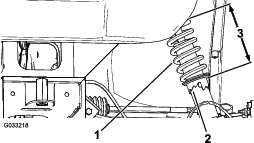
Adjusting the Front Wheel Toe-in
Important: Before adjusting toe-in, ensure that the camber adjustment is as close to neutral as possible; refer to Adjusting the Camber.
-
Measure the distance between both of the front tires at the axle height at both the front and rear of the front tires (Figure 56).
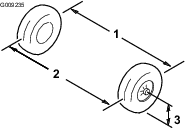
-
If the measurement does not fall within 0 to 6 mm (0 to 1/4 inch), loosen the jam nuts at the outer end of the tie rods (Figure 57).
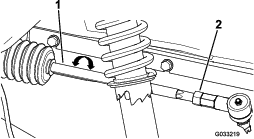
-
Rotate both tie rods to move the front of the tire inward or outward.
-
Tighten the tie rod jam nuts when the adjustment is correct.
-
Ensure that there is full travel of the steering wheel in both directions.
Checking the Transaxle-Fluid Level
| Maintenance Service Interval | Maintenance Procedure |
|---|---|
| Every 100 hours |
|
Fluid Type: SAE 10W30 (API service SJ or higher)
-
Park the machine on a level surface, engage the parking brake, shut off the engine, and remove the key.
-
Remove the bolt from the level-indicating hole (Figure 58).
Note: The transaxle fluid level should be at the bottom of the level indicator hole.

-
If the transaxle fluid is not level with the bottom of the level indicating hole, fill the reservoir with the specified fluid; refer to Changing the Transaxle Fluid.
Changing the Transaxle Fluid
| Maintenance Service Interval | Maintenance Procedure |
|---|---|
| Every 800 hours |
|
Fluid Type: SAE 10W30 (API service SJ or higher)
Fluid Capacity: 1.4 L (1.5 US qt)
-
Park the machine on a level surface, engage the parking brake, shut off the engine, and remove the key.
-
Wipe the area around the fill and drain plugs clean with a rag (Figure 59).
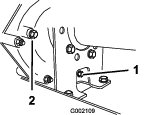
-
Align a drain pan with a capacity of 2 L (2.1 qt) or more under the drain plug.
-
Remove the fill plug by rotating it counterclockwise (Figure 59).
Note: Retain the fill plug and gasket for installation in step 8.
-
Remove the drain plug by rotating it counterclockwise (Figure 59).
Note: Retain the drain plug and gasket for installation in step 6.
Note: Allow the fluid to drain from the transaxle completely.
-
Install and tighten the drain plug and gasket into the drain-plug hole of the transmission (Figure 59).
Note: Dispose of the used fluid at a certified recycling center.
-
Fill the reservoir (Figure 60) through the fill-plug hole with approximately 1.4 L (1.5 US qt) of the specified fluid or until the fluid level in the transmission is even with the bottom of the threads. (Figure 59).
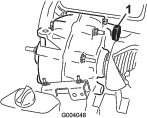
-
Install and tighten the fill plug and gasket into the fill-plug hole of the transmission (Figure 59).
-
Start the engine and operate the machine.
-
Check the fluid level and add more fluid if the level is below the threads of the fill-plug hole (Figure 59).
Checking and Adjusting Neutral
| Maintenance Service Interval | Maintenance Procedure |
|---|---|
| Before each use or daily |
|
| Every 100 hours |
|
When performing routine maintenance and/or engine diagnostics, the transaxle must be shifted into NEUTRAL (Figure 61). The machine has a NEUTRAL position on the shift lever, which controls the neutral in the transaxle. Perform the following steps to ensure that the neutral shift lever operates the transaxle neutral correctly:
-
Set the shift lever into the NEUTRAL position.
-
Ensure that the neutral bracket is in the NEUTRAL position (level to the cable mounting bracket located below the shift bracket) by turning the driven clutch (Figure 61).
Note: The machine should not roll back and forth. If it does, manually move the neutral bracket to the NEUTRAL position.
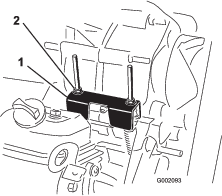
-
Rotate 1 of the locknuts (Figure 61) to achieve a 0.762 to 1.524 mm (0.030 to 0.060 inch) gap between the bottom of the nut/washer and the neutral bracket.
Note: You must hold the threaded shaft below the bracket when adjusting the locknut position on top.
-
Rotate the other locknut to achieve a 0.76 to 1.52 mm (0.03 to 0.06 inch) gap between the bottom of the nut/washer and the neutral bracket.
-
Pull up on each shift cable an ensure that there is a 0.76 to 1.52 mm (0.03 to 0.06 inch) between the nut/washer and the neutral bracket (Figure 62).
Note: If there is a not a gap, adjust the nuts to achieve the specified gap.
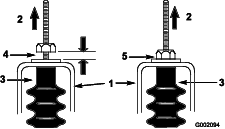
-
Start the engine and shift into FORWARD, REVERSE, and NEUTRAL several times to ensure that the neutral bracket is operating properly.
Maintaining the Primary Drive Clutch
| Maintenance Service Interval | Maintenance Procedure |
|---|---|
| Every 400 hours |
|
Caution
The dust in the clutch will become airborne and could damage your eyes or you could inhale it, causing breathing difficulties.
Wear safety goggles and a dust mask or other eye and respiratory protection when performing this procedure.
-
Raise and latch the cargo bed.
-
Remove the 3 bolts securing the cover to the clutch, and remove the cover (Figure 63).
Note: Retain the cover and bolts for installation.
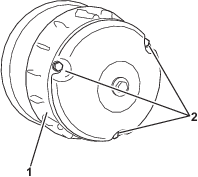
-
Thoroughly clean the inside of the cover and the inner components of the clutch using compressed air.
-
Install the clutch cover and secure it with the 3 bolts (Figure 63) that you removed in 2.
-
Lower the cargo bed.
Reducing the Top Speed
Caution
The dust in the clutch will become airborne and could damage your eyes or you could inhale it, causing breathing difficulties.
Wear safety goggles and a dust mask or other eye and respiratory protection when performing this procedure.
-
Raise and latch the cargo bed; refer to Raising the Cargo Bed.
-
Remove the bolts securing the primary clutch cover as shown in Figure 64.
Important: Use caution when removing the clutch cover; the spring is under compression.
Important: Take note of the X orientation on the clutch covers and clutch assemblies for later installation.
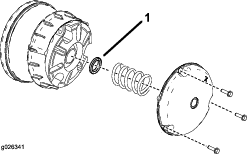
-
Remove the spring.
-
Add or remove spacers to adjust the top speed. Use the following table to determine the amount of spacers needed.
Spacers Top Speed 2 (standard) 16 mph (standard) 3 12 mph 4 9 mph 5 6 mph 6 4 mph Important: Do not operate the machine without at least 2 clutch spacers in place.
-
Install the spring and clutch cover.
Important: Ensure that the X is placed back in the original location.
-
Torque the bolts to 179 to 228 N∙m (132 to 168 in-lb).
Cooling System Maintenance
Cooling System Safety
-
Swallowing engine coolant can cause poisoning; keep out of reach from children and pets.
-
Discharge of hot, pressurized coolant or touching a hot radiator and surrounding parts can cause severe burns.
-
Always allow the engine to cool at least 15 minutes before removing the radiator cap.
-
Use a rag when opening the radiator cap, and open the cap slowly to allow steam to escape.
-
-
Do not operate the machine without the covers in place.
-
Keep your fingers, hands and clothing clear of rotating fan and drive belt.
-
Shut off the engine and remove the key before performing maintenance.
Cleaning the Engine-Cooling Areas
| Maintenance Service Interval | Maintenance Procedure |
|---|---|
| Every 100 hours |
|
Important: Operating the engine with a blocked rotating screen, dirty or plugged cooling fins, or with the cooling shrouds removed, causes engine damage due to overheating.
Important: Never clean the engine with a pressure washer because water could contaminate the fuel system.
Clean the rotating screen, cooling fins, and external surfaces of the engine.
Note: Clean the engine cooling components more often under extremely dusty and dirty conditions.
Brake Maintenance
Inspecting the Brakes
| Maintenance Service Interval | Maintenance Procedure |
|---|---|
| Every 100 hours |
|
Important: Brakes are a critical safety component of the machine. Closely inspect them at the recommended service interval to ensure optimum performance and safety.
-
Inspect the brake lining for wear or damage. If the lining (brake pad) thickness is less than 1.6 mm (1/16 inch), replace the brake lining.
-
Inspect the backing plate and other components for signs of excessive wear or deformation. Replace any deformed components.
-
Check the brake-fluid level; refer to Checking the Brake-Fluid Level.
Adjusting the Parking-Brake Handle
| Maintenance Service Interval | Maintenance Procedure |
|---|---|
| Every 200 hours |
|
-
Remove the handgrip from the parking-brake lever (Figure 65).
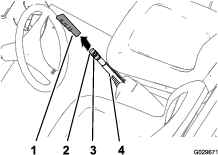
-
Loosen the set screw securing the brake-adjustment knob to the parking-brake lever (Figure 65).
-
Rotate the brake-adjustment knob until you reach a force of 133 to 156 N (30 to 35 lbf) to engage the parking-brake lever (Figure 65).
Note: If you rotated the brake-adjustment knob the full travel of the adjuster, and cannot attain the force of 133 to 156 N (30 to 35 lbf) required to engage the parking-brake lever, perform the procedure for adjusting the brake cables; refer to Adjusting the Brake Cables.
-
Tighten the set screw and install the hand grip (Figure 65).
Adjusting the Brake Cables
-
Remove the handgrip from the parking-brake lever (Figure 65).
-
Loosen the set screw (Figure 65) securing the brake-adjustment knob to the parking-brake lever, disengage the parking brake, and loosen the brake-adjustment knob.
-
At the bottom of the machine, loosen the rear jam nut for the threaded adjuster of the parking-brake cable 4 turns (Figure 66).
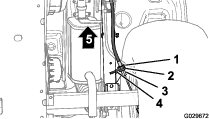
-
Tighten the forward jam nut (Figure 66).
-
Rotate the brake-adjustment knob (Figure 65) until a force of 133 to 156 N (30 to 35 lbf) is required to engage the parking-brake lever.
-
If you cannot adjust the brake-adjustment knob by loosening it and engage the parking-brake lever with a force of 133 to 156 N (30 to 35 lbf), perform the following:
-
Loosen the forward jam nut (Figure 66) for the threaded adjuster of the parking-brake cable 1 turn.
-
Tighten the rear jam nut (Figure 66).
-
Rotate the brake-adjustment knob (Figure 65) until a force of 133 to 156 N (30 to 35 lbf) is required to engage the parking-brake lever.
-
Repeat steps 1 through 3 up to 2 more times to attain the parking brake force between 133 to 156 N (30 to 35 lbf).
-
-
If you cannot adjust the brake-adjustment knob by tightening it and engage the parking-brake lever with a a force of 133 to 156 N (30 to 35 lbf), perform the following:
-
Loosen the rear jam nut (Figure 66) for the threaded adjuster of the parking-brake cable 1 turn.
-
Tighten the forward jam nut (Figure 66).
-
Rotate the brake-adjustment knob (Figure 65) until a force of 133 to 156 N (30 to 35 lbf) is required to engage the parking-brake lever.
-
Repeat steps 1 through 3 up to 3 more times to attain the parking brake force between 133 to 156 N (30 to 35 lbf).
Note: If you cannot adjust the parking-brake cable enough to get the brake-adjustment knob within its adjustment range, check the brake pads for excessive wear.
-
-
Tighten the set screw and install the handgrip (Figure 65).
-
Checking the Brake-Fluid Level
| Maintenance Service Interval | Maintenance Procedure |
|---|---|
| Before each use or daily |
|
Brake-fluid type: DOT 3
-
Park the machine on a level surface.
-
Engage the parking brake.
-
Shut off the engine and remove the key.
-
Raise the hood to access to the master brake cylinder and reservoir (Figure 67).
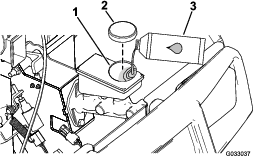
-
Look at the outline of the fluid level at the side of the reservoir (Figure 68).
Note: The level should be above the Minimum line.
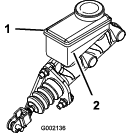
-
If the fluid level is low, preform the following:
-
Close the hood.
Changing the Brake Fluid
| Maintenance Service Interval | Maintenance Procedure |
|---|---|
| Every 1,000 hours |
|
Contact your authorized Toro distributor.
Belt Maintenance
Servicing the Drive Belt
Checking the Drive Belt
| Maintenance Service Interval | Maintenance Procedure |
|---|---|
| After the first 8 hours |
|
| Every 200 hours |
|
-
Park the machine on a level surface, engage the parking brake, shut off the engine, and remove the key.
-
Raise the cargo bed and secure it with the prop rod.
-
Shift the transmission to the NEUTRAL position.
-
Rotate and inspect the belt (Figure 69) for signs of excessive wear or damage.
Note: Replace the belt if it is excessively worn or damaged; refer to Replacing the Drive Belt.
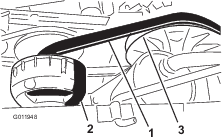
-
Lower the cargo bed.
Replacing the Drive Belt
-
Raise the cargo bed.
-
Shift the transmission into NEUTRAL, engage the parking brake, rotate the key switch to the OFF position, and remove the key.
-
Rotate and route the belt over the secondary clutch (Figure 69).
-
Remove the belt from the primary clutch (Figure 69).
Note: Discard the old belt.
-
Align the new belt over the primary clutch (Figure 69).
-
Rotate and route the belt over the secondary clutch (Figure 69).
-
Lower the cargo bed.
Adjusting the Starter-Generator Belt
| Maintenance Service Interval | Maintenance Procedure |
|---|---|
| After the first 8 hours |
|
| Every 200 hours |
|
-
Raise the cargo bed.
-
Loosen the pivot nut for the starter generator (Figure 70).
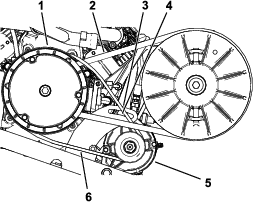
-
Align a pry bar between the engine mount and starter.
-
Apply downward pressure to the pry bar to rotate the starter down in the slot until the belt tension only allows 6 mm (1/4 inch) belt deflection with 44 N∙m (10 ft-lb) of force (Figure 70).
-
Tighten the pivot nut by hand, and remove the pry bar (Figure 70).
-
Torque the pivot nut to 88 to 115 N∙m (65 to 85 ft-lb).
-
Lower the cargo bed.
Chassis Maintenance
Adjusting the Cargo-Bed Latches
If the cargo-bed latch is out of adjustment, the cargo bed vibrates up and down as you drive the machine. You can adjust the latch posts to make the latches hold the cargo bed snugly to the chassis.
Cleaning
Washing the Machine
The machine should be washed as needed. Use water alone or with a mild detergent. A rag may be used when washing the machine.
Important: Do not use power washing equipment to wash the machine. Power washing equipment may damage the electrical system, loosen important decals, or wash away necessary grease at friction points. Avoid excessive use of water near the control panel, engine, and battery.
Important: Do not wash the machine with the engine running. Washing the machine with the engine running may result in internal engine damage.
Storage
Storage Safety
-
Let the entire machine cool before storing it.
-
Do not store the machine or fuel near flames or drain the fuel indoors.
Storing the Machine
| Maintenance Service Interval | Maintenance Procedure |
|---|---|
| After the first 50 hours |
|
| Every 200 hours |
|
| Every 400 hours |
|
| Every 600 hours |
|
-
Position the machine on a level surface, engage the parking brake, shut off the engine, and remove the key.
-
Clean dirt and grime from the entire machine, including the outside of the engine.
-
Inspect the brakes; refer to Inspecting the Brakes.
-
Service the air cleaner; refer to Servicing the Air Filter.
-
Seal the air-cleaner inlet and the exhaust outlet with weatherproof tape.
-
Grease the machine; refer to Lubrication.
-
Change the engine oil; refer to Servicing the Engine Oil.
-
Flush the fuel tank with fresh, clean fuel.
-
Secure all fuel system fittings.
-
Check the tire pressure; refer to Checking the Tire Pressure.
-
Check anti freeze protection and add a 50/50 solution of water and anti freeze as needed for expected minimum temperature in your area.
-
Remove the battery from the chassis, check the electrolyte level, and charge it fully; refer to Servicing the Battery.
Note: Do not connect the battery cables to the battery posts during storage.
Important: The battery must be fully charged to prevent it from freezing and being damaged at temperatures below 0°C (32°F). A fully charged battery maintains its charge for about 50 days at temperatures lower than 4°C (40°F). If the temperatures will be above 4°C (40°F), check the water level in the battery and charge it every 30 days.
-
Check and tighten all bolts, nuts, and screws. Repair or replace any part that is damaged.
-
Paint all scratched or bare metal surfaces.
Note: Paint is available from your Authorized Service Dealer.
-
Store the machine in a clean, dry garage or storage area.
-
Cover the machine to protect it and keep it clean.
